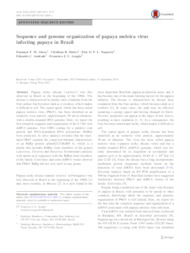Sequence and genome organization of papaya meleira virus infecting papaya in Brazil.
Sequence and genome organization of papaya meleira virus infecting papaya in Brazil.
Autoria: ABREU, E. F. M.; DALTRO, C. B.; NOGUEIRA, E. O. P. L.; ANDRADE, E. C.; ARAGAO, F. J. L.
Resumo: Papaya sticky disease ('meleira') was first observed in Brazil at the beginning of the 1980s. The disease is characterized by intense latex exudation from the fruit surface that becomes dark as it oxidizes, which makes it difficult to sell. The causal agent, which has been called papaya meleira virus (PMeV), has been identified as an isometric virus particle, approximately 50 nm in diameter, with a double-stranded RNA genome. Here, we report the first complete sequence and organization of the 8.7-kb viral dsRNA genome. Two ORFs coding for a putative coat protein and RNA-dependent RNA polymerase (RdRp) were predicted. In silico analysis revealed that the translated ORF2 contains the conserved domains characteristic of an RdRp protein (pfam02123:RdRP 4), which is a family that includes RdRps from members of the genera Luteovirus, Totivirus and Rotavirus. Evolutionary analysis with amino acid sequences with the RdRps from members of the family Totiviridae and some dsRNA viruses showed that PMeV RdRp did not root itself in any genus.
Ano de publicação: 2015
Tipo de publicação: Artigo de periódico
Palavras-chave: Mamão, Meleira, Papaya sticky disease, Papayas
Observações
1 - Por padrão são exibidas publicações dos últimos 20 anos. Para encontrar publicações mais antigas, configure o filtro ano de publicação, colocando o ano a partir do qual você deseja encontrar publicações. O filtro está na coluna da esquerda na busca acima.
2 - Para ler algumas publicações da Embrapa (apenas as que estão em formato ePub), é necessário ter, no celular ou computador, um desses softwares gratuitos. Sistemas Android: Google Play Livros; IOS: iBooks; Windows e Linux: software Calibre.
Acesse outras publicações
Acesse a Base de Dados da Pesquisa Agropecuária (BDPA) para consultar o acervo completo das bibliotecas da Embrapa.

